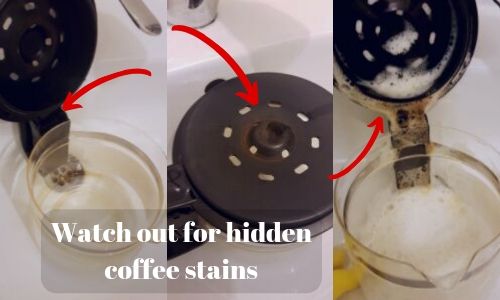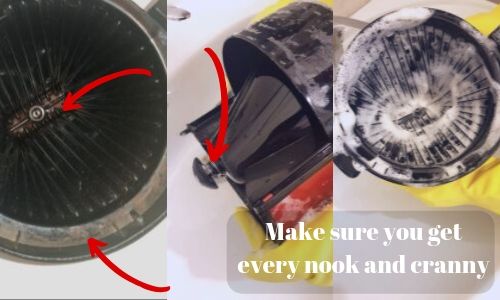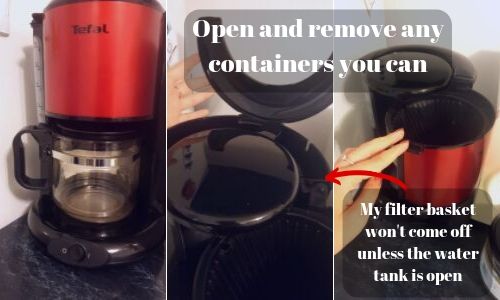Your coffee maker, like mine, needs a thorough cleaning every now and then. We're all guilty of forgetting to rinse it and then we have to really wash the thing.
But how do you clean a coffee maker, top to bottom, inside and out ?
Here's my guide on how to do that, and some tips I've learned through trial and error on how to keep the coffee maker clean in the long run.

Table of Contents
Daily coffee maker rinse
A daily water rinse sounds like a ''well, duh'' thing but how many of us really stop to do this in the morning ? Exactly. I was guilty of this for the first few months of owning my coffee maker.
It's not a big deal machine, it's a black and red Tefal with basically no extra options than ON/OFF button but man do I love that thing.
So here's what I've learned helps to do every day, so you don't have to do much more at the end of the week. And so things don't build up until then.
1. Always run a water rinse after each use
Right after I make coffee in the morning, I have another large glass of water on stand-by so I can pour it into the water tank and run a water rinse. This rinse will clean most of the leftover coffee in the carafe, and rinse the filter basket as well.
It won't wash away the coffee oils in the filter basket, but it will make the whole thing cleaner and you won't see those nasty brown lines appearing on the bottom of your carafe.
2. Wipe hot plate to keep coffee spots from sticking
Often, if you don't let your coffee drip until it's completely done, you'll get another drop or two of coffee on the hot plate when you remove the carafe.
Sometimes it even happens when you just pull out the carafe and move the filter a bit and a drop falls from the nub.
Whichever case, those drops are never fun since they can and will get sticky if you let them live there. So I recommend you grab a TP square, or even just a bit of paper towel and wipe that drop right as it happens.
Since the hot plate (the part keeping your carafe hot) is going to be hot, I suggest you don't press too hard onto it or the heat might travel through the paper and onto your finger.
Weekly coffee maker scrub down
A weekly scrub down is still necessary, even if you do rinse the coffee maker every day, after each use. After all, coffee has its coffee oils and definitely needs a good scrub with some dish soap to really go away.
Plus, there will always be some buildup where you least expect it. Also a quick wipe-down to get rid of any dust that accumulated during the week is a nice touch.
Please make sure to unplug your coffee maker before you take any item out or apply water to them.
1. Wash the carafe, and the lid with hot water and dish soap

Now, washing the carafe itself is pretty straightforward. All you have to do is to get a good dish sponge and thoroughly wash the inside, keeping a bit of water inside to create enough suds.
The inside is easy. But the outside and the lid are always going to give you a bit of hell.
First, make sure you scrub right under the beak, since there's always a dried drop of coffee there.
Then, make sure you scrub down the top of the lid, where the drip holes are. There's always lots of coffee there, and if you've got a black lid (like I do), they're not easy to see.
Do your best to scrub and rinse and scrub again those holes and the raised middle part to get all the buildup off.
Then open the lid and do the same on the inside. You'll notice the suds are brown there. That means you had coffee there, good, now you know just where to scrub.
If your carafe lid is a screw top (adjustable height), then some coffee will always be hiding there because when you open the lid to let it breathe, it will collect in the grooves.
You'll only notice it's there when the suds from the dish soap get brown and show you where there's buildup.
So make sure you get every nook and cranny, since those are the hardest to clean and have the most buildup, which can affect the coffee taste and your health.
Take care of the handle too, for example mine has a sort of hinge that has a drop or two of coffee all the time.
2. Take out the filter basket and scrub it well

Another thing to really take care of is to scrub the living daylights out of your filter basket. Mine is detachable, so I can bring it to the sink. I hope yours is too.
So if it's detachable you need to scrub it down with water and dish soap, and let the suds run through the drip/nub to start cleaning that too.
You're going to need to follow any groove and crevice that you filter might have, and really scrub the bottom part, where you might find more collected coffee than you'd think at first.
If you've got a good dish brush, you can use that as well as a sponge to really get in there. Be patient, and make sure to rinse it until nothing brown or no suds come out.
But if your filter isn't detachable you can do the same thing only with less water and soap, but more scrubbing and way more care to not spill over on the counter. And please make sure to unplug your machine before your start !!
Remember that coffee contains some oils, and you will need to really scrub, even if it might not seem entirely necessary at first. Trust me, built up coffee oils can give your coffee a rancid, acrid taste.
3. Don't forget to clean the shower head/water feeder
This part gets overlooked all. the. time. I know I didn't even think of this one for the first 2 months and when I did check I was king of shocked.
So, when the water does reach your coffee in the filter, it does so from an overhead water feeds, and some look like a shower head (with multiple holes).
When the water touches ground coffee, the coffee will bloom, which means it will make a sort of foam and release CO2. A natural reaction, and one that's going to sprinkle your water feeder with droplets of coffee.
Over time these build up too, so you need to wipe them off. The shower head can't be taken out, so you will need to just use a clean, damp towel and wipe the buildup away, then use a dry one and wipe it dry.
After you've wiped and scrubbed everything down, let each item dry out before placing them back in the coffee maker.
Monthly vinegar or solution rinse
A monthly rinse is necessary, since it will help remove any bad odors or taste from the water tank. At least it will if you do it regularly, and it should protect your machine in the long run.
Do keep in mind that whatever you put in the water tank will be exposed to a metal heating element, which can and will get coated in limestone, especially if you live in a hard water area.
Rinse coffee maker with descaling treatment once per month
You can use a descaling treatment once a month to keep your coffee maker safe, and have two options: either you use a vinegar and water rinse, or a descaling solution.
If your coffee maker comes with an auto-clean option be sure to use that, and read the instruction manual. Mine has no such option so a normal cycle will do the same job.
And however much liquid you decide to use, make sure the total amount is not more than your carafe can easily hold.
Vinegar and water rinse
Vinegar is a long-time friend of anyone looking to keep their home clean, along with baking soda. This time we're leaving soda behind and just using vinegar.
You will need 1:2 vinegar to water ratio, and exactly how much total liquid you use is up to you. But keep in mind that this solution is going to smell so string you're definitely going to need to rise with just water 3 times after.
So, in a large cup add one part vinegar and two parts water, give it a mix with a spoon, and pour it into the water tank. Turn the coffee maker on, and let the machine do its job.
Once the cycle is done, throw out the liquid and add plain water and run a rise, 2 more times. if you can still smell or taste some vinegar in the water, run another rinse.
Descaling solution
Another option, if your nose is too sensitive to vinegar (mine is, especially warm/hot vinegar) then you'll want to use a descaling solution. It's usually a mixture of citrus salts and another cleaning agent, which will pretty much do the same job as vinegar, minus the smell.
Mine come in small, one-use packages and you're meant to dissolve one pack in 500 ml/17 oz of water and let the machine run a cycle. Once it's done, you will again need to rinse 2 more times with plain water.
And as long as you do that every month you should be fine and have n limestone buildup to speak of.
A good descaling solution for your coffee maker
A good descaling solution will save you a lot of trouble in the long run. For example this one by Essential Values, even if sounds like a lower-end brand, still manages to do the job very well.
It comes in a two bottle pack, and each bottle is good for two uses. So you get 4 uses with this deal, which will last your 4 months if you use one descaling rinse per month.
It's a liquid solution, so it's going to be easier to dissolve/mix into the water thank than a powdered one.
You can check the listing on Amazon, and read the reviews as well.
Tips on keeping your coffee maker mold and gunk free
These are my main tips on keeping my coffee maker mold free, and gunk free. Those nasty things form mostly because of moisture, so the main key here is to... not let it happen.
Ha, I know, so helpful. But I'll tell you what to do to make sure moisture doesn't build up.
1. Always keep let the water tank breathe when not in use
Your water tank needs to breathe and have some air circulate, I learned this the hard way after I noticed it has a lot of condensation on the inside and the water wasn't the best.
Stale water isn't cool, and the smell does build up on the inner walls of the water tank, which will affect your coffee in time.
What I do is right after I do the plain water rinse (daily), I let open the water tank lid completely, and let is sit like that while we have breakfast and get ready for work.
When we're about to leave (so about 30-40 minutes later) I use a clothespin to prop the lid open an inch or so. So it's mostly closed so no dust or random piece of hair fly into the water tank, but it's got room to breathe as well.
2. Keep the filter basket open an inch, to let it breathe
The same story is true for the filter basket. Mine just opens to the side, like a cupboard. After the water rise I open it all the way, and let it dry out completely.
Then before we leave for work I close it almost all the way, leaving a small gap for some air to escape.
It also means I get no instantly moist coffee filters when I make coffee the next morning, which I think is a plus
3. Keep the carafe lid open for a few minutes after removing coffee
The carafe deserves the same treatment. After pouring out all the coffee, and then the water rinse, I always leave the lid wide open.
This makes sure there is no condensation in the carafe, and it's completely dry by the time I close it back before we leaves for work.
It also helps the carafe cool down very fast.
4. Use bottled water if you have poor tap water
If you're in an area with hard water, or if your water's been iffy recently I suggest you use bottled water.
You might think it's pointless if you already have tap water, but hear me out.
Where we live the water's very good, very rocky terrain, close to a mountain and the streams are mostly clear. The water filtration system is good too, so bad water was never a thing.
Until one day when we came back from a vacation in July 2018, after a couple of weeks of torrential rain.
The water purifying system didn't really work, I think. It might've been too much. But we had rank, yellow and light brown water for a whole month. Even if you let it run for 5 minutes the color would be slightly better but the taste and smell was bad.
Cooking and coffee was done exclusively with bottled water, but just one round of coffee was made with that water. Boy did I regret trusting that cup of water.
After I was done I checked the water tank, and found a thin film of sediments on the bottom. Ugh. I rinsed it as much as I could, but the damage was done and my hand couldn't really reach more than the first 4-5 inches of the tank.
So heed my warning and only use bottled water for water tanks you can't take out and wash or scrub.
5. Never let water sit in the tank if not in use
Most coffee makers have water tanks way larger than one or two cups of coffee, because maybe you want tot serve 10 cups at a time. Fair enough.
But many people treat the coffee maker's water tank like it's a dam. Don't let water just sit there if all you're doing is making coffee once a day, every morning.
It will sit and get an odd taste, and it won't be because of the metal or plastic parts. Still waters are just rank, much like the bottom of a puddle. You don't want to know what's on the bottom.
How do you fix it ? Only use as much water as you need for one or two or however many cups of coffee you're making.
Let the machine sputter when it runs out of water. That's not pleasant to hear, but you can be sure there's no leftover water. And the heat from the heating element will help evaporate any water droplets that may be left.
Final thoughts
Cleaning a coffee maker is just making sure you get a good cup of coffee each time you make one. It makes sense to take care of what's yours, and as such I suggest you really take care of those daily and weekly routines I mentioned.
They might a be 3 extra minutes each day and another half hour each weekend, but really in the long run you'll be thankful.
If you want to know more about coffee or tea, feel free to check the related articles below. Who knows what else you might find ?






